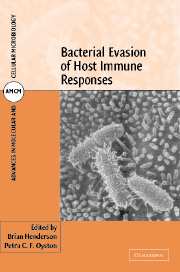Book contents
- Frontmatter
- Contents
- Contributors
- Preface
- Part I Recognition of bacteria
- Part II Evasion of humoral immunity
- Part III Evasion of cellular immunity
- 7 Type III secretion and resistance to phagocytosis
- 8 Bacterial superantigens and immune evasion
- 9 Bacterial quorum sensing signalling molecules as immune modulators
- 10 Microbial modulation of cytokine networks
- 11 Enterotoxins: Adjuvants and immune inhibitors
- 12 Type III protein secretion and inhibition of NF-κB
- Index
- Plate section
- References
11 - Enterotoxins: Adjuvants and immune inhibitors
from Part III - Evasion of cellular immunity
Published online by Cambridge University Press: 13 August 2009
- Frontmatter
- Contents
- Contributors
- Preface
- Part I Recognition of bacteria
- Part II Evasion of humoral immunity
- Part III Evasion of cellular immunity
- 7 Type III secretion and resistance to phagocytosis
- 8 Bacterial superantigens and immune evasion
- 9 Bacterial quorum sensing signalling molecules as immune modulators
- 10 Microbial modulation of cytokine networks
- 11 Enterotoxins: Adjuvants and immune inhibitors
- 12 Type III protein secretion and inhibition of NF-κB
- Index
- Plate section
- References
Summary
INTRODUCTION
Toxins are defined as “soluble substances that alter the normal metabolism of host cells with deleterious effects on the host” (Schlessinger and Schaechter, 1993). Enterotoxins in particular elicit their primary effect in the intestinal tract, initiating a metabolic cascade that results in excessive fluid and electrolyte secretion. The uniform host response is the development of diarrhoea. However, at a cellular and subcellular level, certain enterotoxins induce sophisticated and fascinating metabolic alterations, which can also affect the local immune system in a characteristic fashion. Occasionally, enterotoxins induce disease even outside the gastrointestinal tract, affecting other organ systems. Enterotoxins can be stimulatory and inhibitory at the same time, depending on the encountered cell type. Further, the same toxin can have more than one effect, either inducing or suppressing the immune cascade. Modulation of the immune cascade with either induction or suppression of local and systemic immunocompetent cell populations is initiated at the level of the mucosal immune systems of the lungs, urogenital tract, cornea, and gut. Gut-associated lymphoid tissue (GALT) is a mixture of immunocompetent cells in the intestinal lining, constantly exposed to foreign antigens and tightly regulated to prevent continuous activation. However, even the massive, continuous exposure to foreign antigens in the intestinal lumen does not, under normal circumstances, lead to a measurable immune response. This lack of response to antigens is known as oral tolerance.
How exactly do antigens and enterotoxins gain access to the host immune system and what are the tolerance-defining cell populations in the GALT?
- Type
- Chapter
- Information
- Bacterial Evasion of Host Immune Responses , pp. 243 - 278Publisher: Cambridge University PressPrint publication year: 2003

